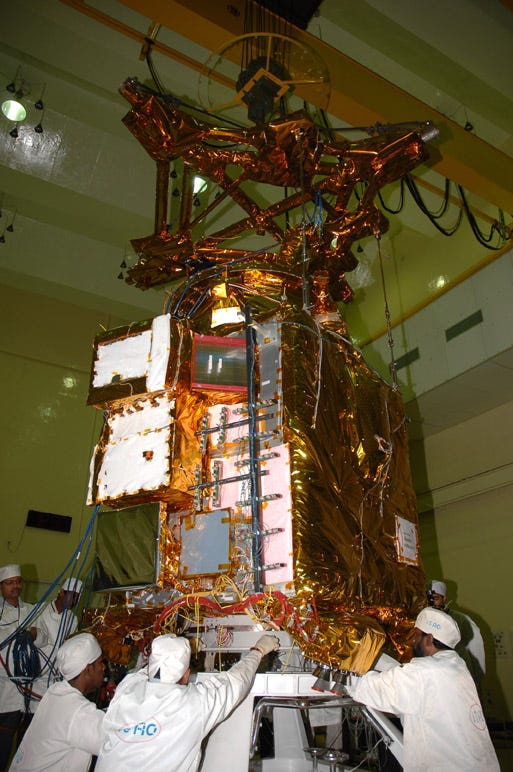Rust on the Moon: Unraveling the Mystery of Hematite Formation
Written on
Chapter 1: The Enigma of Lunar Rust
The presence of rust on the Moon raises intriguing questions: how did it come to be in such an inhospitable environment? Surprisingly, Earth may hold a key role in this phenomenon. Observations made by the Chandrayaan-1 spacecraft, which orbited our lunar companion, revealed complex interactions among the Sun, Earth, and Moon that could explain the formation of rust, known scientifically as iron oxide.
Despite the Moon's lack of water and oxygen, iron oxide was detected within hematite deposits—an iron-rich mineral—by the lunar orbiter over a decade ago. Typically, hematite forms on Earth through the reaction of oxygen and water with iron deposits. Given that water is scarce on the Moon, except in polar craters, and oxygen is limited, researchers are left wondering how such minerals could exist.

The Moon Mineralogy Mapper (M3) on the lunar orbiter identified signs of hematite, which should not appear in the Moon's dry conditions. While Mars's reddish surface is attributed to iron oxide, it was once abundant in water, unlike the Moon. "Initially, I was skeptical. Hematite shouldn't exist under the Moon's conditions. However, the discovery of water there has led to speculation about a wider range of minerals that could arise from its interaction with lunar rocks," stated Abigail Fraeman from the Jet Propulsion Laboratory (JPL).
Section 1.1: The Role of Solar Wind

The solar wind, a continuous flow of charged particles from the Sun, brings hydrogen to both the Earth and Moon. This hydrogen acts as a reducer, inhibiting the formation of hematite by adding electrons to molecules. For hematite to form, iron must lose electrons, which is counteracted by the solar wind's effects on the lunar surface.
Interestingly, a small amount of oxygen from Earth's atmosphere is transported via its magnetic field and deposited on the Moon. Data from M3 indicated higher hematite concentrations on the Moon's near side compared to the far side, hinting that the oxygen found on the Moon likely originated from Earth. Initially, when the Earth-Moon system formed, they were much closer, and some oxygen may have been transferred during that time.

"When analyzing M3 data in polar regions, I noticed distinct spectral features differing from those at lower latitudes or Apollo samples. This led me to wonder about possible water-rock reactions on the Moon. After extensive investigation, I realized I was observing hematite signatures," recalled Shuai Li from the Hawaii Institute of Geophysics and Planetology.
Section 1.2: Shielding from the Solar Wind
As the Moon travels behind the Earth during a full moon, it experiences a protective shield from the solar wind. This respite allows oxygen to interact with iron, creating conditions conducive to hematite formation.
"The absence of a significant atmosphere on the Moon allows the solar wind—primarily composed of hydrogen—to penetrate its surface, implanting itself in the top layers of lunar soil," researchers noted in their publication in Science Advances. They likened the slow oxidation process to a gradual form of rusting, akin to how civilizations can be subtly eroded over time.

The essential component for rust formation is water. Although the Moon has water ice at its poles, the hematite deposits are distanced from these icy regions. Researchers propose that water may be released by fast-moving dust particles during impacts. When the Moon is shielded by Earth, conditions may allow hematite to form. This study could also provide insights into how water on other airless bodies, such as asteroids, might have originated.
"Small amounts of water, along with dust impacts, may facilitate the rusting of iron on these celestial bodies," suggested Fraeman.
Chandrayaan-1, launched on October 22, 2008, marked India's inaugural mission to the Moon. The spacecraft orbited at an altitude of 100 km (62 miles), utilizing 11 instruments to study the lunar surface. After completing its scientific objectives in May 2009, it ascended to 200 kilometers (125 miles) until contact was lost in August 2009.
The forthcoming Lunar Trailblazer mission, being developed by JPL and Caltech, aims to further investigate water ice deposits on the Moon, potentially solving the mystery surrounding hematite on its surface.
James Maynard, the founder and publisher of The Cosmic Companion, is a New England native now residing in Tucson with his wife, Nicole, and their cat, Max.
Did you find this article insightful? Join us on The Cosmic Companion Network for podcasts, weekly video series, newsletters, and news briefings on Amazon Alexa!